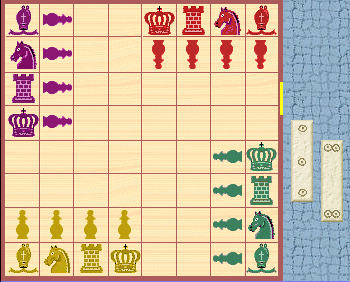

Chaturanga for four players probably originated in India about 1000 years ago, and is believed to be a development of 2-handed Chaturanga. At least until the end of the 19th century, a variant of 4-handed Chaturanga was played in several parts of India. In medieval times, the game was mostly played with dice (four-sided long dice), often with stakes involved.
The four players form two teams of two players. Red plays together with yellow, and green plays together with black. The king, rook, and knight move as in orthodox chess. Pawns, too, move as in orthodox chess, but have no initial double move. The boat jumps two squares diagonally.
The first team that has taken both opponents’ kings wins the game. The medieval long dice determine which piece can be moved. To throw the dice, click on the left die. One can make two moves in a row, or choose to pass one or both moves. The long die has four sides, showing 2, 3, 4, and 5. Its values are as follows: 2 = boat, 3 = knight, 4 = rook, 5 = king or pawn. You must pass manually if you don’t own the piece anymore.
A player can not move his pieces after his own king is captured (the program will pass his moves automatically). However, should the partner capture an enemy king, then the immobilized party can re-introduce a king, and become mobile again. The immobilized player can introduce this king on an empty square anywhere on the board. In this case he has no second move, so he must pass the second move. Note that a king that has been captured twice cannot be introduced again.
Pawns promote to any of the four types: rook, knight, boat, or king. Piece-type is determined by the promotion square. For Yellow, the a-, and h-files are boat-files, as the boats’ initial squares are on these files. Hence, Yellow promotes to boats on a8 and h8, knights on b8 and g8, rooks on c8 and f8, and kings on d8 and e8.
It is possible to capture one’s partners pieces. However, in my interpretation, capture of the partner’s king is prohibited (that would be unethical!).
Discussion
Note that, sometimes, it is possible to put one’s own piece en prise, provided that one’s partner has the intermediate move, so that he can remove the threatening piece. It is a common tactics to take a chance and put a piece on a threatened square, hoping that the dice will not allow the opponent to catch the piece. It is a highly cooperative game. Unlike in orthodox chess, the king is not a passive piece. It is often possible to attack with the king, especially when one’s partner’s king is still on the board (otherwise it could be too risky, as losing the king would lose the game).
This is a very fast and aggressive game, very suitable for gambling. In fact, in medieval times there were additional gambling rules connected with 4-handed Chaturanga. A player that moves his king to the starting square (throne) of another player wins a single stake. One can get only one such stake per opponent. A player who moves his king to the throne of an opponent, and with doing so also takes this king, wins a double stake. A game could be over fast. If Yellow strikes 2+2 he can capture the Black king with his boat. Next, if his partner, Red, strikes 2+2 he can capture the Green king. This wins the game.
(The piece set builds on a True Type font by Armando Marroquin, used in Palview, and has been coloured by me.)
References
Murray, HJR (1913). A History of Chess. Oxford: At the Clarendon Press.
Four-handed Chaturanga. Chess Variants pages.
You can download my free 4-handedChaturanga program (updated 2009-12-24) here, but you must own the software Zillions of Games to be able to run it.
© Mats Winther, 2006.